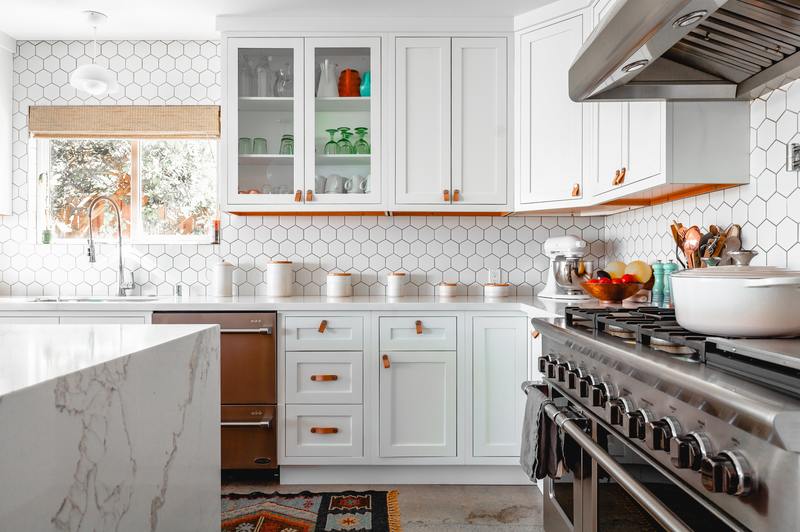If you want to learn how to repair water damaged MDF kitchen cabinet, they should be sanded, filled, and painted. Doing this will surely restore your cabinet’s form, so read on for an in-depth tutorial!

What happens when MDF gets wet?
Medium-density fiberboard, or MDF, is a popular choice for kitchen cabinets. It’s durable, stylish, and cheap. Since it’s engineered wood, MDF is versatile.
However, MDF has its downsides. Even if MDF can withstand extreme temperatures, it can still be susceptible to water exposure.
When MDF gets wet, like regular wood, it becomes swollen. Wet MDF can deteriorate quickly like damp cardboard.
What should you do if this happens to your MDF kitchen cabinets? Don’t worry; you can still do something about it.
Repairing Water Damaged MDF Kitchen Cabinets
If your MDF kitchen cabinets become water-damaged, here’s a step-by-step guide on how to repair them.
Step #1. Assessing the situation
Before attempting to repair your kitchen cabinets, you’ll need to check their condition. If the water damage on your kitchen cabinets is beyond repair, then you should consider getting them replaced.
Telltale signs of significant water damage include crumbled and separated MDF particles. If most of your kitchen cabinets look like this, replacing them is a better idea.
If your MDF kitchen cabinets only have a few swollen sections, then you can opt to repair them on your own. You can also call the help of a professional. Homeowner’s insurance sometimes covers expenses for water damage repairs.
Step #2. Repairing your MDF cabinets
It might sound like a big task, but repairing your MDF cabinets can be easy! Before starting, you’ll need sandpaper, resin glue, wood filler, primer, paint, and a water-resistant sealant.
Make sure that the MDF cabinets are dry before repairing them. To do this, you should remove all the items inside the cabinet. The next step is to leave the cabinet to dry for a few days.
Remove any hardware that might be damaged when you sand the cabinets. You can also lay a sheet of plastic on the floor to protect it from dirt and paint.
2.1 Sanding
It’s time to even out the surface of the MDF cabinets. Remove swollen parts by sanding over them with coarse-grit sandpaper.
You’ll need to change the sandpaper a few times. Try to sand only the areas that are affected by water damage.
The water-damaged areas should be sanded repeatedly to get an even finish. A little elbow grease is needed for this project.
2.2 Resin Glue
For the areas that the sandpaper couldn’t reach, apply some resin glue with a brush. You can put resin glue on cracks, seams, and pits.
Try to put an even coat of resin glue. When you’re done applying the glue, you should leave it to dry overnight.
The resin glue will shrink as it dries. Don’t worry, it’s normal. That’s why wood filler is used to fill in any other dents.
2.3 Wood Filler
Using a spatula or blunt knife, smooth the wood filler over the cracks and seams that the resin glue couldn’t fill. Try to put an even layer of this wood filler.
Once again, it would be best if you let the putty dry overnight. Unlike resin glue, this one won’t shrink.
When it’s dry, you’ll need to sand the putty using coarse grit sandpaper. You can do this several times to achieve a smooth and even surface.
Step #3: Finishing touches
If you’re already happy with how the wood filler turned out, then it’s time for the finishing touches. Prepare your paint brushes, primer, paint, and sealant.
3.1 Priming
To make sure that the sticks well to the MDF, apply a primer. A primer can help seal the particles in the MDF. Primer also adds a layer of protection against water damage.
Use alcohol-based or oil-based primers instead of water-based primers. The MDF will only absorb water-based primers. Once the primer is dry, it’s now time to paint your MDF kitchen cabinets.
3.2 Painting
Paint one to two coats of water-resistant paint on the cabinets. Choose a color that matches the cabinets’ original color.
3.3 Sealant
Now that your cabinets look as good as new, it’s time to put sealant on them. Sealant is the last step for added protection against water damage.
How do you waterproof MDF kitchen cabinets?
MDF kitchen cabinets are prone to water damage, even more so if they’re near the sink or the refrigerator. What can you do to prevent water damage from ruining your MDF cabinets?
There are a few precautions that you can take. A common practice is to use water-resistant primer, paint, and sealant to protect MDF kitchen cabinets.
Be wary of musty smells and wet or moist MDF kitchen cabinets. If you notice water damage, it’s best to repair them right away. Leaving water damage unattended can be troublesome.
Conclusion
MDF kitchen cabinets are stylish, durable, and affordable. However, don’t forget to take care of them.
If you ever notice water damage on your cabinets, don’t worry! You now know how to repair water damaged MDF kitchen cabinet.
